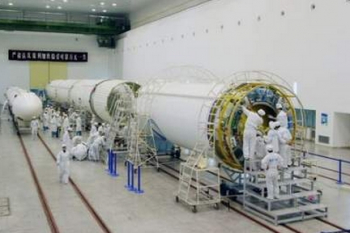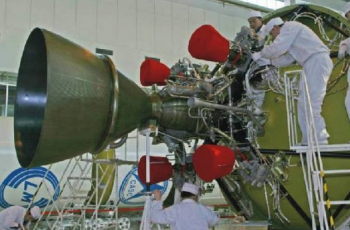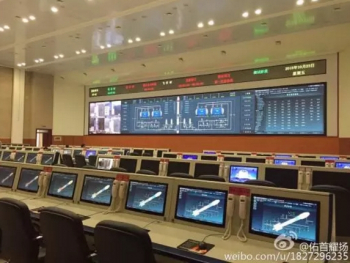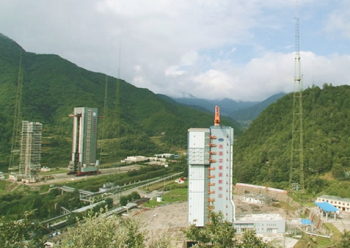Long March 3B lofts Chinasat-1C
December 9, 2015 by Rui C. Barbosa
China launched the second of a new generation of tactical communications satellites. Zhongxing-1C – or Chinasat-1C – was launched at 16:46 UTC on December 9, 2015 – from the Xichang Satellite Launch Center. A Long March-3B/G2 rocket was used to loft the spacecraft uphill.
Chinese Launch:
Zhongxing-1C is possibly the second satellite of the second generation Fenghuo geostationary tactical military communication satellites based on the DFH-4 satellite platform.
China uses two types of satellites for secure military communications: the Fenghuo and the Shentong. The Fenghuo series is used for tactical military communications, providing secured digital data and voice communication to Chinese military forces.
The Chinese are currently operating the DFH-4 based Fenghuo-2 second-generation satellite, with the first of the series the Zhongxing-1A (37804 2011-047A) launched at 13:33 UTC on September 18th, 2011, by the Chang Zheng-3B (Y16) rocket.
See Also
The Shentong geostationary military communication satellites are operated by the Army and their aim is to provide secured voice and data communications services for ground users using Ku-band. Recently China launched the Zhongxing-2C (Chinasat-2C), the second satellite of the second generation of the Shentong series.
DFH-4 is the third generation communications satellite bus in China with high power, strong payload capacity and extended service life. It consists of a propulsion module, service modules and solar arrays. Its dimensions are 2360mm×2100mm×3600mm, with a liftoff mass of 5,200 kg. Solar Array Power is 10.5 kW (EOL) and payload power is 8 kW.
The platform can be equipped with C, Ku, Ka and L transponders. It uses a 3-axis stabilization mode and its station keeping precision is west/east ±0.05° and north/south ±0.05°. The Antenna Pointing Precision is <0.1°. Service life time in orbit is 15 years.
Launch vehicle and launch site:
To meet the demand of international satellite launch market, especially for high power and heavy communications satellites, the development of Long March-3B (Chang Zheng-3B) launch vehicle was started in 1986 on the basis of the fight proven technology of Long March launch vehicles.
Developed from the Chang Zheng-3A, the Chang Zheng-3B is at the moment the most powerful launch vehicle on the Chinese space launch fleet.
The CZ-3B features enlarged launch propellant tanks, improved computer systems, a larger 4.2 meter diameter payload fairing and the addition of four strap-on boosters in the core stage that provide additional help during the first phase of the launch.
The rocket is capable of launching a 11,200 kg satellite to a low Earth orbit or a 5,100 kg cargo to a geosynchronous transfer orbit.
The CZ-3B/G2 (Enhanced Version) launch vehicle was developed from the CZ-3B with a lengthened first core stage and strap-on boosters, increasing the GTO capacity up to 5,500kg.
On May 14, 2007, the first flight of CZ-3B/G2 was performed successfully, accurately sending the NigcomSat-1 into pre-determined orbit. With the GTO launch capability of 5,500kg, CZ-3B/G2 is dedicated for launching heavy GEO communications satellite.
The rocket structure also combines all sub-systems together and is composed of four strap-on boosters, a first stage, a second stage, a third stage and payload fairing.
The first two stages as well as the four strap-on boosters use hypergolic (N2O4/UDMH) fuel while the third stage uses cryogenic (LOX/LH2) fuel. The total length of the CZ-3B is 54.838 meters, with a diameter of 3.35 meters on the core stage and 3.00 meters on the third stage.
On the first stage, the CZ-3B uses a YF-21C engine with a 2,961.6 kN thrust and a specific impulse of 2,556.5 Ns/kg. The first stage diameter is 3.35 m and the stage length is 23.272 m.
Each strap-on booster is equipped with a YF-25 engine with a 740.4 kN thrust and a specific impulse of 2,556.2 Ns/kg. The strap-on booster diameter is 2.25 m and the strap-on booster length is 15.326 m.
The second stage is equipped with a YF-24E (main engine – 742 kN / 2,922.57 Ns/kg; four vernier engines – 47.1 kN / 2,910.5 Ns/kg each). The second stage diameter is 3.35 m and the stage length is 12.920 m.
The third stage is equipped with a YF-75 engine developing 167.17 kN and with a specific impulse of 4,295 Ns/kg. The fairing diameter of the CZ-3B is 4.00 meters and has a length of 9.56 meters.
The CZ-3B can also use the new Yuanzheng-1 (Expedition-1″) upper stage that uses a small thrust 6.5 kN engine burning UDMH/N2O4 with specific impulse at 3,092 m/s. The upper stage is able to conduct two burns, having a 6.5 hour lifetime and is capable of achieving a variety of orbits. This upper stage was not used on this launch.
Typical flight sequence for the CZ-3B/G2 sees the launch pitching over 10 seconds after liftoff from the Xichang Satellite Launch Centre. Boosters shutdown 2 minutes and 7 seconds after liftoff, separation from the first stage one second latter. First stage shutdown takes place at 1 minutes 25 seconds into the flight.
Separation between the first and second stage takes place at 1 minute 26 seconds, following fairing separation at T+3 minutes 35 seconds. Stage 2 main engine shutdown occurs 326 seconds into the flight, following by the shutdown of the vernier engines 15 seconds later.
Separation between the second and the third stage and the ignition of the third stage takes place one second after the shutdown of the vernier engines of the second stage. The first burn of the third stage will lasts for 4 minutes and 44 seconds.
After the end of the first burn of the third stage follows a coast phase that ends at T+20 minutes and 58 seconds with the third stage initiating its second burn. This will have a 179 seconds duration. After the end of the second burn of the third stage, the launcher initiates a 20 second velocity adjustment maneuver. Spacecraft separation usually takes place at T+25 minutes 38 seconds after launch.
The Xichang Satellite Launch Centre is situated in the Sichuan Province, south-western China and is the countrys launch site for geosynchronous orbital launches.
Equipped with two launch pads (LC2 and LC3), the centre has a dedicated railway and highway lead directly to the launch site.
The Command and Control Centre is located seven kilometers south-west of the launch pad, providing flight and safety control during launch rehearsal and launch.
Other facilities on the Xichang Satellite Launch Centre are the Launch Control Centre, propellant fuelling systems, communications systems for launch command, telephone and data communications for users, and support equipment for meteorological monitoring and forecasting.
The first launch from Xichang took place at 12:25UTC on January 29, 1984, when the Chang Zheng-3 (Y1) was launched the Shiyan Weixing (14670 1984-008A) communications satellite into orbit.
Long March 3B lofts Chinasat-1C | NASASpaceFlight.com
2015年12月10日00时46分我国在西昌用CZ-3B火箭发射中星1C卫星—在线播放—优酷网,视频高清在线观看
Amateur launch video






















